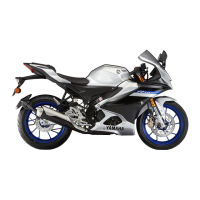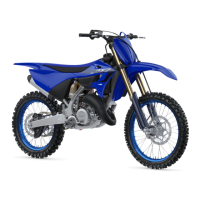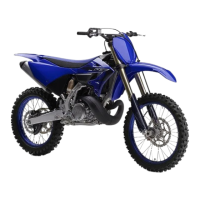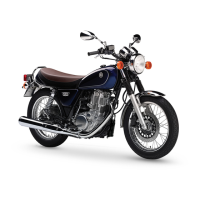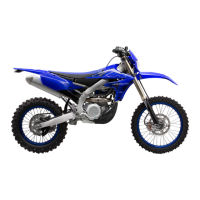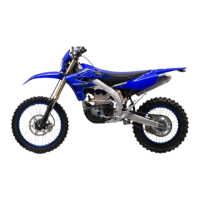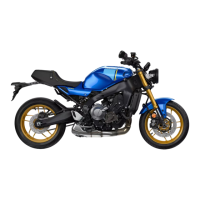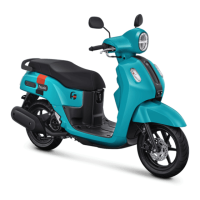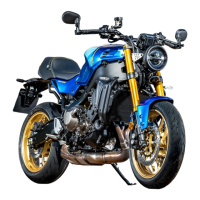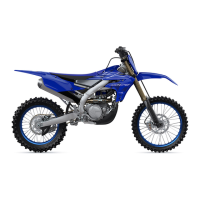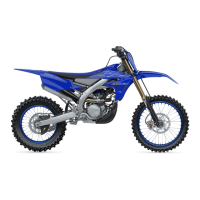Do you have a question about the Yamaha 135LC 2022 and is the answer not in the manual?
Read this manual carefully and completely before operating this motorcycle.
This is the safety alert symbol. It is used to alert you to potential personal injury hazards.
A WARNING indicates a hazardous situation which, if not avoided, could result in death or serious injury.
A NOTICE indicates special precautions that must be taken to avoid damage to the vehicle or other property.
A TIP provides key information to make procedures easier or clearer.
Warning label in Bahasa: Read manual before use.
Caution label in Bahasa: Do not wash vehicle with seat open.
Tire pressure information with values for different loads.
Owner's responsibility for safe operation and importance of proper training.
Performing pre-operation checks, posture, and visibility.
Essential protective gear including helmet, face shield, jacket, boots, and gloves.
Hazards of engine exhaust and guidelines for loading accessories safely.
Importance of genuine parts and safety considerations for aftermarket modifications.
Advice on signaling, braking, cornering, and crossing hazards.
Identification of major components on the left side of the motorcycle.
Identification of major components on the right side of the motorcycle.
Overview of handlebar switches, levers, and dashboard controls.
Operation of the main switch for ignition, lighting, and steering lock.
How to open and close the keyhole cover.
Explanation of dashboard indicator lights, warnings, and their meanings.
Overview of meter displays including gear, speed, fuel, and tachometer.
Details on gear display, odometer, tripmeters, and consumption displays.
Procedure for setting the clock and viewing instantaneous fuel usage.
Displays for average fuel, average speed, and battery voltage.
Controls for dimmer, signals, horn, starter, and gear shifting.
Operation of brake levers/pedals and fuel tank access.
Safety guidelines for refueling, including fire prevention and handling gasoline.
Purpose of the catalytic converter and safety warnings for the hot exhaust system.
Steps to open/close the seat and use helmet holders.
Information on the DC connector and sidestand operation/warnings.
Checking fuel, engine oil, coolant levels, and front brake components.
Checking rear brake, throttle grip, drive chain, cables, and tires.
Checking pedals, levers, fasteners, lights, signals, and switches.
Guidelines for the initial 1600 km (1000 mi) to ensure engine longevity.
Step-by-step instructions for starting the engine, including warnings.
How to shift gears, use the shift pedal, and proper techniques.
Riding advice for fuel efficiency and safe parking procedures.
Benefits of proper use and maintenance for vehicle performance and longevity.
Information on the included tool kit and when to seek dealer assistance.
Scheduled checks and maintenance for the emission control system.
Scheduled maintenance tasks and lubrication points for various vehicle components.
Inspection of tires, wheel bearings, steering, drive chain, and fasteners.
Maintenance for suspension, engine oil, cooling system, and brake switches.
Lubrication of throttle grip and checks for lights and signals.
Procedure for inspecting the spark plug for condition and gap.
Checking oil level, changing oil, and replacing the oil filter element.
How to check and add coolant, and procedure for changing coolant.
Instructions for replacing the air filter element.
Procedure to check and adjust engine idling speed and throttle grip free play.
Importance and procedure for checking valve clearance and tire maintenance.
How to inspect tires and list of Yamaha-approved tire specifications.
Checking cast wheels for damage and brake lever free play.
Ensuring smooth shift pedal operation and adjusting brake light switch.
Procedure for checking brake pad wear using indicator grooves.
How to check brake fluid levels and procedure for changing brake fluid.
Procedure for changing brake fluid and checking/adjusting drive chain slack.
Steps for cleaning and lubricating the drive chain and checking control cables.
Lubricating throttle grip/cable and brake lever/pedal pivots.
Checking and lubricating centerstand, sidestand, and swingarm pivots.
Inspecting the front fork and checking steering bearings for wear.
Inspecting wheel bearings and battery safety precautions.
Procedure for replacing blown fuses and fuse specifications.
Information on LED lights and replacing front turn signal bulbs.
Step-by-step guide to replacing a rear turn signal bulb.
Replacing license plate bulb and front wheel removal/installation.
Instructions for removing and installing the rear wheel.
General advice on diagnosing and resolving common vehicle problems.
Procedure for checking coolant levels and diagnosing overheating issues.
Advice on cleaning and waxing matte-finished parts.
Tips for washing, cleaning, and polishing the vehicle.
Drying, polishing, and protecting the vehicle after washing.
Advice on storing the vehicle in a cool, dry place and preventing rust.
Recording vehicle and engine serial numbers for reference.
Location of diagnostic connector and vehicle data storage.
| Displacement | 134 cc |
|---|---|
| Bore x Stroke | 54.0 mm x 58.7 mm |
| Compression Ratio | 10.9:1 |
| Fuel System | Fuel Injection |
| Ignition System | TCI |
| Final Drive | Chain |
| Front Suspension | Telescopic fork |
| Rear Suspension | Swingarm |
| Front Brake | Disc |
| Rear Brake | Drum |
| Front Tire | 70/90-17M/C 38P |
| Wheelbase | 1, 255 mm |
| Wet Weight | 109 kg |
| Engine Type | 4-stroke, SOHC |
| Transmission | 5-Speed |
| Fuel Tank Capacity | 4.0 L |
| Starter | Electric |

